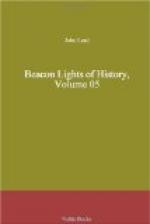inspiration of the Catholic Church. They are
indeed hoary monuments, petrified mysteries, a “passion
of stone,” as Michelet speaks of the marble histories
which will survive his rhapsodies. They alike
show the pilgrimage of humanity through gloomy centuries.
If their great wooden screens were removed, which
separate the choir from the nave, the cathedrals doubtless
would appear to more advantage, and especially if
they were filled with altars and shrines and pictures,
and lighted candles on the altars,—filled
also with crowds of worshippers, reverent before the
gorgeously attired ministers of Divine Omnipotence,
and excited by transporting chants, and the various
appeals to sense and imagination. The reason must
be assisted by the imagination, before the mind can
revel in the glories of Gothic architecture.
Imagination intensifies all our pleasures, even those
of sense; and without imagination—yea, a
memory stored with the pious deeds of saints and martyrs
in bygone ages—a Gothic cathedral is as
much a sealed book as Wordsworth is to Taine.
The Protestant tourist from Michigan or Pennsylvania
can “do” any cathedral in two hours, and
wonder why they make such a fuss about a church not
half so large as the New York Central Railroad station.
The wonders of cathedrals must be studied, like the
glories of a landscape, with an eye to the beautiful
and the grand, cultured and practised by the contemplation
of ideal excellence, when the mind summons the imagination
to its aid, with all the poetry and all the history
which have been learned in a life of leisure and study.
How different the emotions of a Ruskin or a Tennyson,
in surveying those costly piles, from those of a man
fresh from a distillery or from a warehouse of cotton
fabrics, or even from those of many fashionable women,
whose only aesthetic accomplishment is to play languidly
and mechanically on an instrument, and whose only intellectual
achievement is to have devoured a dozen silly novels
in the course of a summer spent in alternate sleep
and dalliance! Nor does familiarity always give
a zest to the pleasure which arises from the creations
of art or the glories of nature. The Roman beggar
passes the Coliseum or St. Peter’s without notice
or enjoyment, as a peasant sees unmoved the snow-capped
mountains of Switzerland or the beautiful lakes of
Killarney. Said sorrowfully my guide up the Rhigi,
“I wish I lived in Holland, for there are men
there.” Yet there are those whom the ascent
of Rhigi and the ruined monuments of ancient Rome would
haunt for a lifetime, in whose memory they would be
perpetually fresh, never to pass away, any more than
the looks and the vows of early love from the mind
of a sentimental woman.
The glorious old architecture whose peculiarity was the pointed arch, flourished only about three hundred years in its purity and matchless beauty. Then another change took place. The ideal became lost in meaningless ornaments. The human figure peoples the naked walls. “Man places his own image everywhere.... The tomb rises like a mausoleum in side chapels. Man is enthroned, not God.” The corruption of the art keeps pace with the corruption of the Papacy and the discords of society. In the fourteenth century the Mediaeval has lost its charm and faith.




